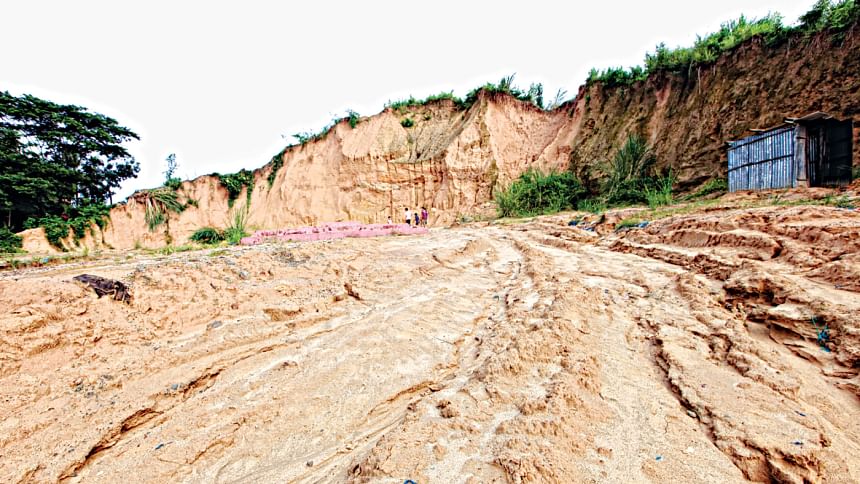How hills of Sylhet turn flat

There are laws, High Court order, protests of environmentalists and a dedicated government office to keep vigilance, but nothing can stop hillock cutting in Sylhet.
For over two decades, around half the hillocks have been razed, environmental activists claimed.
It may lead to serious environmental disasters, they said.
As urbanisation of Sylhet city is happening fast, the demand for plain land to construct buildings is rising and hillocks are being cut.
Hillock cutting is rampant mostly in Sylhet city and its suburbs which falls in Sylhet Sadar upazila.
Hillocks have been damaged in Hawladarpara, Karerpara, Gowabari, Bagmara, Dolia, and Baluchar and many other places of Sylhet city and its suburbs.
The Bangladesh Environment Conservation Act, 1995 (amended 2010), strictly prohibits the cutting or razing of any types of hills and hillocks by any individual or institution. Exceptions may be made, but only after a clearance certificate is issued by the Department of Environment (DoE).
Moreover, on November 2011, Bangladesh Environmental Lawyers Association (Bela) filed a writ petition with the High Court to stop hillock cutting and the court banned cutting of any types of hillock in Sylhet.
Recently, hillock cutting at Gowabari Tila and Majumdar Tila in Sylhet city's ward-8 and its adjacent areas in the Sadar upazila is being heavily criticised.
Majumdar Tila is being ravaged for years, part by part, and now hillock cutting is going on there at nights.
Lawyer Dilip Kumar Deb, a resident of Hawladarpara, said, "Many hillocks, including Majumdar Tila, have been ravaged in the last couple of years. Owners and their associates cut the hillock at nights so that they cannot be noticed. Officials are aware of it, but they don't take any necessary steps to stop this."
The Gowabari Tila was being cut using the excavator of Sylhet City Corporation. On August 26, the DoE fined Nur Uddin, brother of ward-8 councillor, Tk 1.40 lakh for cutting the hillock.
Councillor Iliasur Rahman was also fined Tk 1 lakh for cutting hillock inside his house in 2015.
Locals alleged that they patronise the activities in the ward and its adjacent areas.
Refuting the allegation, the councillor said, "In no way I am involved, rather I informed the DoE several times of taking legal actions."
"Hillock owners need plain land to sell or construct houses. They give the task to contractors to cut the hillocks. They ravage the hillocks at nights, sell the soil and even if they are fined, they pay the fine on their own. The hillock owners always stay clean," he said.
Emran Hossain, director of DoE in Sylhet, said though they have limited manpower, they remain vigilant on hillock cutting and are taking action whenever they find such incidents.
"In last one month, we conducted six drives against hillock cutting at different spots, including the Majumdar Tila, and fined those involved in the activities Tk 8.50 lakh," he said, adding that people should inform them if they notice any hillocks are being destroyed.
However, environmental activists claim that such drives and fines will not stop hillock cutting completely.
Abdul Karim Kim, general secretary of Bangladesh Paribesh Andolon (Bapa) Sylhet chapter, said, "After hillock cutting, prices of the land increase four to five times higher than normal. Comparing to that, the amount of fine is nothing for these people."
"The will of the DoE is also questionable. It only takes actions when any specific hillock cutting surfaces. They conduct drive, fine some people, arrest labourers sometimes, but the hillock owners remain untouched," he said.
There must be a separate department like forest or haor or river to protect hills and hillocks of the country, Kim urges, saying, "The land department knows which land is classified as hillock in the legal documents.
"The owners who cut hillocks must be identified and punished legally -- that is the way the hillock cutting may be stopped."

 For all latest news, follow The Daily Star's Google News channel.
For all latest news, follow The Daily Star's Google News channel. 



Comments